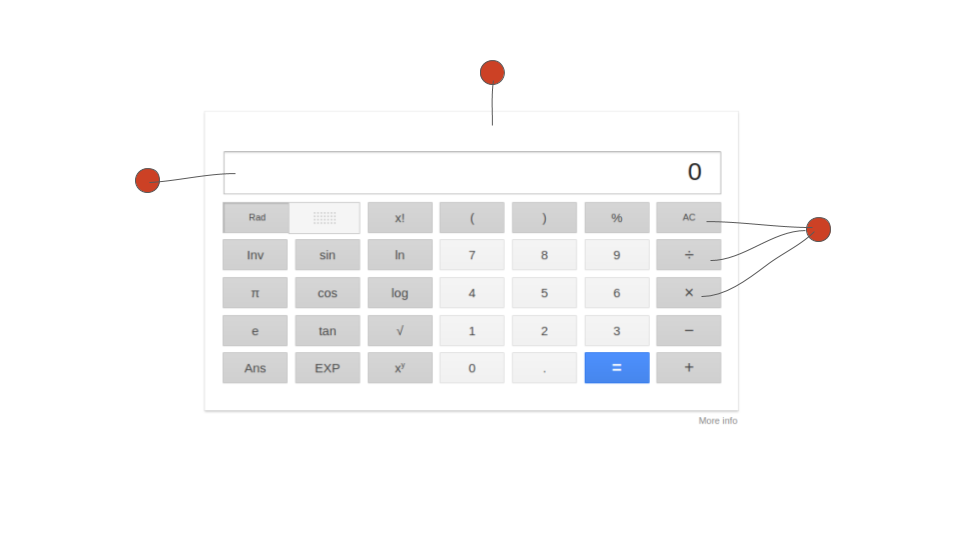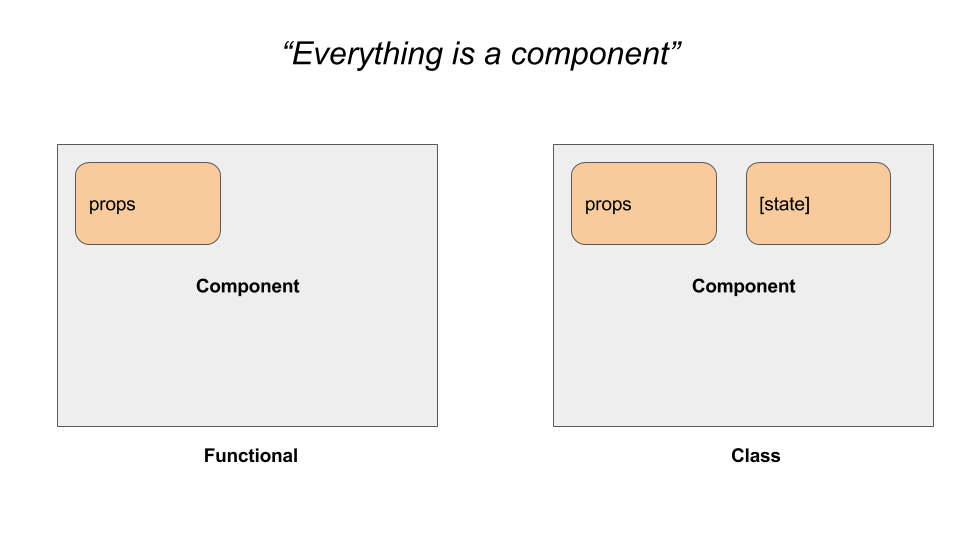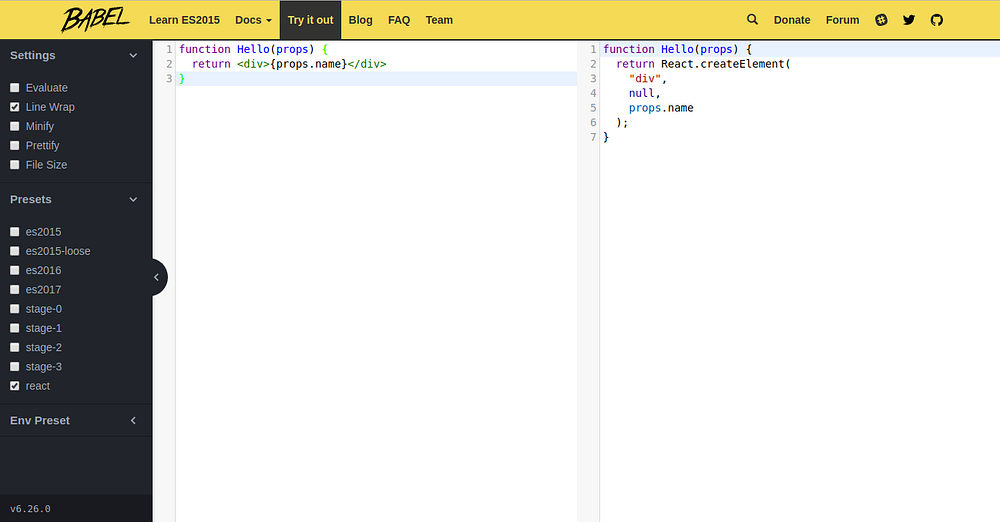mirror of
https://github.com/LCTT/TranslateProject.git
synced 2025-01-19 22:51:41 +08:00
292 lines
12 KiB
Markdown
292 lines
12 KiB
Markdown
Rock Solid React.js Foundations: A Beginner’s Guide
|
||
============================================================
|
||
** 此处有Canvas,请手动处理 **
|
||
|
||

|
||
React.js crash course
|
||
|
||
I’ve been working with React and React-Native for the last couple of months. I have already released two apps in production, [Kiven Aa][1] (React) and [Pollen Chat][2] (React Native). When I started learning React, I was searching for something (a blog, a video, a course, whatever) that didn’t only teach me how to write apps in React. I also wanted it to prepare me for interviews.
|
||
|
||
Most of the material I found, concentrated on one or the other. So, this post is aimed towards the audience who is looking for a perfect mix of theory and hands-on. I will give you a little bit of theory so that you understand what is happening under the hood and then I will show you how to write some React.js code.
|
||
|
||
If you prefer video, I have this entire course up on YouTube as well. Please check that out.
|
||
|
||
|
||
Let’s dive in…
|
||
|
||
> React.js is a JavaScript library for building user interfaces
|
||
|
||
You can build all sorts of single page applications. For example, chat messengers and e-commerce portals where you want to show changes on the user interface in real-time.
|
||
|
||
### Everything’s a component
|
||
|
||
A React app is comprised of components, _a lot of them_ , nested into one another. _But what are components, you may ask?_
|
||
|
||
A component is a reusable piece of code, which defines how certain features should look and behave on the UI. For example, a button is a component.
|
||
|
||
Let’s look at the following calculator, which you see on Google when you try to calculate something like 2+2 = 4 –1 = 3 (quick maths!)
|
||
|
||
|
||

|
||
Red markers denote components
|
||
|
||
As you can see in the image above, the calculator has many areas — like the _result display window_ and the _numpad_ . All of these can be separate components or one giant component. It depends on how comfortable one is in breaking down and abstracting away things in React
|
||
|
||
You write code for all such components separately. Then combine those under one container, which in turn is a React component itself. This way you can create reusable components and your final app will be a collection of separate components working together.
|
||
|
||
The following is one such way you can write the calculator, shown above, in React.
|
||
|
||
```
|
||
<Calculator>
|
||
<DisplayWindow />
|
||
<NumPad>
|
||
<Key number={1}/>
|
||
<Key number={2}/>
|
||
.
|
||
.
|
||
.
|
||
<Key number={9}/>
|
||
</NumPad>
|
||
</Calculator>
|
||
|
||
```
|
||
|
||
Yes! It looks like HTML code, but it isn’t. We will explore more about it in the later sections.
|
||
|
||
### Setting up our Playground
|
||
|
||
This tutorial focuses on React’s fundamentals. It is not primarily geared towards React for Web or [React Native][3] (for building mobile apps). So, we will use an online editor so as to avoid web or native specific configurations before even learning what React can do.
|
||
|
||
I’ve already set up an environment for you on [codepen.io][4]. Just follow the link and read all the comments in HTML and JavaScript (JS) tabs.
|
||
|
||
### Controlling Components
|
||
|
||
We’ve learned that a React app is a collection of various components, structured as a nested tree. Thus, we require some sort of mechanism to pass data from one component to other.
|
||
|
||
#### Enter “props”
|
||
|
||
We can pass arbitrary data to our component using a `props` object. Every component in React gets this `props` object.
|
||
|
||
Before learning how to use this `props` object, let’s learn about functional components.
|
||
|
||
#### a) Functional component
|
||
|
||
A functional component in React consumes arbitrary data that you pass to it using `props` object. It returns an object which describes what UI React should render. Functional components are also known as Stateless components.
|
||
|
||
Let’s write our first functional component.
|
||
|
||
```
|
||
function Hello(props) {
|
||
return <div>{props.name}</div>
|
||
}
|
||
```
|
||
|
||
It’s that simple. We just passed `props` as an argument to a plain JavaScript function and returned, _umm, well, what was that? That _ `_<div>{props.name}</div>_` _thing!_ It’s JSX (JavaScript Extended). We will learn more about it in a later section.
|
||
|
||
This above function will render the following HTML in the browser.
|
||
|
||
```
|
||
<!-- If the "props" object is: {name: 'rajat'} -->
|
||
<div>
|
||
rajat
|
||
</div>
|
||
```
|
||
|
||
|
||
> Read the section below about JSX, where I have explained how did we get this HTML from our JSX code.
|
||
|
||
How can you use this functional component in your React app? Glad you asked! It’s as simple as the following.
|
||
|
||
```
|
||
<Hello name='rajat' age={26}/>
|
||
```
|
||
|
||
The attribute `name` in the above code becomes `props.name` inside our `Hello`component. The attribute `age` becomes `props.age` and so on.
|
||
|
||
> Remember! You can nest one React component inside other React components.
|
||
|
||
Let’s use this `Hello` component in our codepen playground. Replace the `div`inside `ReactDOM.render()` with our `Hello` component, as follows, and see the changes in the bottom window.
|
||
|
||
```
|
||
function Hello(props) {
|
||
return <div>{props.name}</div>
|
||
}
|
||
|
||
ReactDOM.render(<Hello name="rajat"/>, document.getElementById('root'));
|
||
```
|
||
|
||
|
||
> But what if your component has some internal state. For instance, like the following counter component, which has an internal count variable, which changes on + and — key presses.
|
||
|
||
A React component with an internal state
|
||
|
||
#### b) Class-based component
|
||
|
||
The class-based component has an additional property `state` , which you can use to hold a component’s private data. We can rewrite our `Hello` component using class notation as follows. Since these components have a state, these are also known as Stateful components.
|
||
|
||
```
|
||
class Counter extends React.Component {
|
||
// this method should be present in your component
|
||
render() {
|
||
return (
|
||
<div>
|
||
{this.props.name}
|
||
</div>
|
||
);
|
||
}
|
||
}
|
||
```
|
||
|
||
We extend `React.Component` class of React library to make class-based components in React. Learn more about JavaScript classes [here][5].
|
||
|
||
The `render()` method must be present in your class as React looks for this method in order to know what UI it should render on screen.
|
||
|
||
To use this sort of internal state, we first have to initialize the `state` object in the constructor of the component class, in the following way.
|
||
|
||
```
|
||
class Counter extends React.Component {
|
||
constructor() {
|
||
super();
|
||
|
||
// define the internal state of the component
|
||
this.state = {name: 'rajat'}
|
||
}
|
||
|
||
render() {
|
||
return (
|
||
<div>
|
||
{this.state.name}
|
||
</div>
|
||
);
|
||
}
|
||
}
|
||
|
||
// Usage:
|
||
// In your react app: <Counter />
|
||
```
|
||
|
||
Similarly, the `props` can be accessed inside our class-based component using `this.props` object.
|
||
|
||
To set the state, you use `React.Component`'s `setState()`. We will see an example of this, in the last part of this tutorial.
|
||
|
||
> Tip: Never call `setState()` inside `render()` function, as `setState()` causes component to re-render and this will result in endless loop.
|
||
|
||
|
||

|
||
A class-based component has an optional property “state”.
|
||
|
||
_Apart from _ `_state_` _, a class-based component has some life-cycle methods like _ `_componentWillMount()._` _ These you can use to do stuff, like initializing the _ `_state_` _and all but that is out of the scope of this post._
|
||
|
||
### JSX
|
||
|
||
JSX is a short form of _JavaScript Extended_ and it is a way to write `React`components. Using JSX, you get the full power of JavaScript inside XML like tags.
|
||
|
||
You put JavaScript expressions inside `{}`. The following are some valid JSX examples.
|
||
|
||
```
|
||
<button disabled={true}>Press me!</button>
|
||
|
||
<button disabled={true}>Press me {3+1} times!</button>;
|
||
|
||
<div className='container'><Hello /></div>
|
||
|
||
```
|
||
|
||
The way it works is you write JSX to describe what your UI should look like. A [transpiler][6] like `Babel` converts that code into a bunch of `React.createElement()` calls. The React library then uses those `React.createElement()` calls to construct a tree-like structure of DOM elements. In case of React for Web or Native views in case of React Native. It keeps it in the memory.
|
||
|
||
React then calculates how it can effectively mimic this tree in the memory of the UI displayed to the user. This process is known as [reconciliation][7]. After that calculation is done, React makes the changes to the actual UI on the screen.
|
||
|
||
** 此处有Canvas,请手动处理 **
|
||
|
||

|
||
How React converts your JSX into a tree which describes your app’s UI
|
||
|
||
You can use [Babel’s online REPL][8] to see what React actually outputs when you write some JSX.
|
||
|
||
|
||

|
||
Use Babel REPL to transform JSX into plain JavaScript
|
||
|
||
> Since JSX is just a syntactic sugar over plain `React.createElement()` calls, React can be used without JSX.
|
||
|
||
Now we have every concept in place, so we are well positioned to write a `counter` component that we saw earlier as a GIF.
|
||
|
||
The code is as follows and I hope that you already know how to render that in our playground.
|
||
|
||
```
|
||
class Counter extends React.Component {
|
||
constructor(props) {
|
||
super(props);
|
||
|
||
this.state = {count: this.props.start || 0}
|
||
|
||
// the following bindings are necessary to make `this` work in the callback
|
||
this.inc = this.inc.bind(this);
|
||
this.dec = this.dec.bind(this);
|
||
}
|
||
|
||
inc() {
|
||
this.setState({
|
||
count: this.state.count + 1
|
||
});
|
||
}
|
||
|
||
dec() {
|
||
this.setState({
|
||
count: this.state.count - 1
|
||
});
|
||
}
|
||
|
||
render() {
|
||
return (
|
||
<div>
|
||
<button onClick={this.inc}>+</button>
|
||
<button onClick={this.dec}>-</button>
|
||
<div>{this.state.count}</div>
|
||
</div>
|
||
);
|
||
}
|
||
}
|
||
```
|
||
|
||
The following are some salient points about the above code.
|
||
|
||
1. JSX uses `camelCasing` hence `button`'s attribute is `onClick`, not `onclick`, as we use in HTML.
|
||
|
||
2. Binding is necessary for `this` to work on callbacks. See line #8 and 9 in the code above.
|
||
|
||
The final interactive code is located [here][9].
|
||
|
||
With that, we’ve reached the conclusion of our React crash course. I hope I have shed some light on how React works and how you can use React to build bigger apps, using smaller and reusable components.
|
||
|
||
* * *
|
||
|
||
If you have any queries or doubts, hit me up on Twitter [@rajat1saxena][10] or write to me at [rajat@raynstudios.com][11].
|
||
|
||
* * *
|
||
|
||
#### Please recommend this post, if you liked it and share it with your network. Follow me for more tech related posts and consider subscribing to my channel [Rayn Studios][12] on YouTube. Thanks a lot.
|
||
|
||
--------------------------------------------------------------------------------
|
||
|
||
via: https://medium.freecodecamp.org/rock-solid-react-js-foundations-a-beginners-guide-c45c93f5a923
|
||
|
||
作者:[Rajat Saxena ][a]
|
||
译者:[译者ID](https://github.com/译者ID)
|
||
校对:[校对者ID](https://github.com/校对者ID)
|
||
|
||
本文由 [LCTT](https://github.com/LCTT/TranslateProject) 原创编译,[Linux中国](https://linux.cn/) 荣誉推出
|
||
|
||
[a]:https://medium.freecodecamp.org/@rajat1saxena
|
||
[1]:https://kivenaa.com/
|
||
[2]:https://play.google.com/store/apps/details?id=com.pollenchat.android
|
||
[3]:https://facebook.github.io/react-native/
|
||
[4]:https://codepen.io/raynesax/pen/MrNmBM
|
||
[5]:https://developer.mozilla.org/en-US/docs/Web/JavaScript/Reference/Classes
|
||
[6]:https://en.wikipedia.org/wiki/Source-to-source_compiler
|
||
[7]:https://reactjs.org/docs/reconciliation.html
|
||
[8]:https://babeljs.io/repl
|
||
[9]:https://codepen.io/raynesax/pen/QaROqK
|
||
[10]:https://twitter.com/rajat1saxena
|
||
[11]:mailto:rajat@raynstudios.com
|
||
[12]:https://www.youtube.com/channel/UCUmQhjjF9bsIaVDJUHSIIKw |